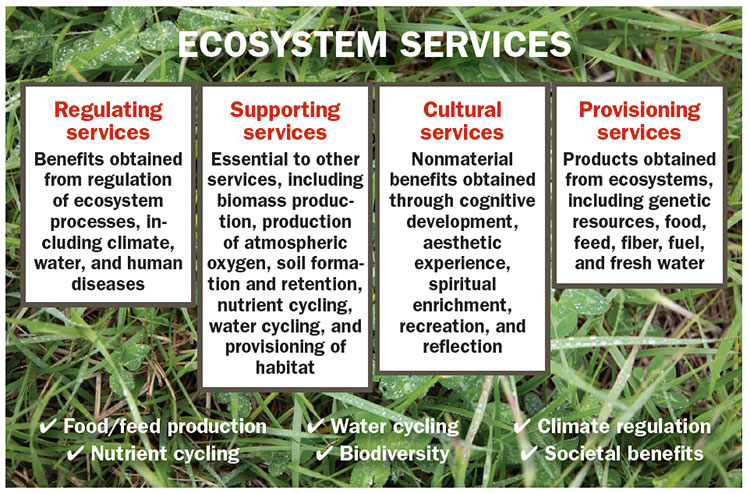The author is a soil scientist with the USDA Agricultural Research Service in Raleigh, N.C.

Each morning, we experience some of the many services of soil — soft cotton fibers from which to arise, clean water to wash our face, firm ground to stand on, and the aromas of brewed coffee, baking pastries, and sizzling bacon.
Benefits we derive from soil and its processes are called ecosystem services. Biomass production and high-quality feedstuffs are vital ecosystem services.
Inherent soil characteristics such as texture and depth to restrictive rock layers might be reasons for differences in productivity. Soil texture is the “fine earth” combination of particle sizes from clay (smallest) to silt (medium) to sand (largest). Of course, in some regions, coarse fragments, rocks, and boulders are present, too.
Depth of soil can determine the total amount of water that can be stored, which influences when drought might start affecting productivity. Soil productivity can also be affected by how it is managed. We can choose to manage soil toward a healthy state, or we can abuse soil, resulting in undesirable consequences for us, our neighbors, and even the global human population and planetary condition.
Nutrients are recycled
Nutrients are continually cycled among the atmosphere, plants, grazing animals, and soils. For example, much of the nitrogen that is taken up by forages is derived from soil. We don’t often test for how much nitrogen soil provides, but if we measured the total nitrogen content of surface soil, it would likely be 10 to 100 times greater than a pasture or hayfield might need during a growing season.
Most soil nitrogen is bound tightly in organic matter and not readily available to plants. Soil microorganisms must consume the organic matter and release inorganic nitrogen that can be acquired by plant roots exploring the soil. Plant nitrogen may be consumed by ruminant livestock, and this nitrogen is used to create animal protein.
Some of the nitrogen will enter our food system, where we gain nutritional benefits from high-protein food. Some of the nitrogen that livestock consume will be returned to soil in urine and feces. During decomposition of these organic additions to soil, a portion of the nitrogen might wash off the soil into surface water or leach through the soil into groundwater.
Losses of nitrogen from the soil can be avoided with good soil management. Soils with healthy nutrient cycling conserve nitrogen in the soil-plant-animal continuum. Similar cycles are present with other nutrients such as phosphorus, potassium, calcium, and magnesium.
The water cycle drives most nutrient cycles, and soil is a key component of the water cycle, too. We all await the day when it rains after a long dry spell in the summer. What if we needed 2 inches of rain to sustain a forage crop to the end of the season, but only 3/4 of an inch soaked into the ground? Then 1 1/4 inch would have run off, and additional rain would be needed to meet plant demand.
Why did that rain run off? Was the soil surface so compacted by animal or tractor traffic? Was bare soil present between widely spaced clumps of grass?
These are factors that can prevent soil from functioning properly. Maintaining soil cover with residual forage mass or surface residue will keep soil organisms active so the pores linking the soil surface with subsoil are available to receive abundant precipitation. Roots, earthworms, and beetles can make these channels, thereby allowing distribution of nutrients flowing from the surface to the rooting zone. The water and nutrient cycles work together effectively when soil is healthy.
Better with biodiversity
Forages and grazing lands can harbor an abundance of biodiversity, but only if we allow them to. Much of that diversity is not seen since many of these organisms may be small insects, spiders, and microorganisms. However, there are many visible species, too, like grasses, trees, birds, bees, rodents, deer, and so forth. The ecosystems we live in are more robust and function more effectively when biodiversity is high. Grasslands can provide abundant biodiversity.
Grasslands are one of many biomes that produce oxygen for us to breathe by transforming carbon dioxide from the atmosphere through the process of photosynthesis. This is a fundamental process we depend on. As land managers, you are caretakers of this natural phenomenon, and this should keep you humble but also fill you with pride.
This article appeared in the August/September 2022 issue of Hay & Forage Grower on page 13.
Not a subscriber? Click to get the print magazine.
